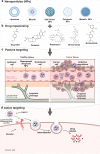Drug repurposing for cancer therapy
- PMID: 38637540
- PMCID: PMC11026526
- DOI: 10.1038/s41392-024-01808-1
Drug repurposing for cancer therapy
Abstract
Cancer, a complex and multifactorial disease, presents a significant challenge to global health. Despite significant advances in surgical, radiotherapeutic and immunological approaches, which have improved cancer treatment outcomes, drug therapy continues to serve as a key therapeutic strategy. However, the clinical efficacy of drug therapy is often constrained by drug resistance and severe toxic side effects, and thus there remains a critical need to develop novel cancer therapeutics. One promising strategy that has received widespread attention in recent years is drug repurposing: the identification of new applications for existing, clinically approved drugs. Drug repurposing possesses several inherent advantages in the context of cancer treatment since repurposed drugs are typically cost-effective, proven to be safe, and can significantly expedite the drug development process due to their already established safety profiles. In light of this, the present review offers a comprehensive overview of the various methods employed in drug repurposing, specifically focusing on the repurposing of drugs to treat cancer. We describe the antitumor properties of candidate drugs, and discuss in detail how they target both the hallmarks of cancer in tumor cells and the surrounding tumor microenvironment. In addition, we examine the innovative strategy of integrating drug repurposing with nanotechnology to enhance topical drug delivery. We also emphasize the critical role that repurposed drugs can play when used as part of a combination therapy regimen. To conclude, we outline the challenges associated with repurposing drugs and consider the future prospects of these repurposed drugs transitioning into clinical application.
© 2024. The Author(s).
Conflict of interest statement
The authors declare no competing interests.
Figures





Similar articles
-
The Black Book of Psychotropic Dosing and Monitoring.Psychopharmacol Bull. 2024 Jul 8;54(3):8-59. Psychopharmacol Bull. 2024. PMID: 38993656 Free PMC article. Review.
-
Systemic pharmacological treatments for chronic plaque psoriasis: a network meta-analysis.Cochrane Database Syst Rev. 2021 Apr 19;4(4):CD011535. doi: 10.1002/14651858.CD011535.pub4. Cochrane Database Syst Rev. 2021. Update in: Cochrane Database Syst Rev. 2022 May 23;5:CD011535. doi: 10.1002/14651858.CD011535.pub5. PMID: 33871055 Free PMC article. Updated.
-
Short-Term Memory Impairment.2024 Jun 8. In: StatPearls [Internet]. Treasure Island (FL): StatPearls Publishing; 2025 Jan–. 2024 Jun 8. In: StatPearls [Internet]. Treasure Island (FL): StatPearls Publishing; 2025 Jan–. PMID: 31424720 Free Books & Documents.
-
Systemic pharmacological treatments for chronic plaque psoriasis: a network meta-analysis.Cochrane Database Syst Rev. 2020 Jan 9;1(1):CD011535. doi: 10.1002/14651858.CD011535.pub3. Cochrane Database Syst Rev. 2020. Update in: Cochrane Database Syst Rev. 2021 Apr 19;4:CD011535. doi: 10.1002/14651858.CD011535.pub4. PMID: 31917873 Free PMC article. Updated.
-
Management of urinary stones by experts in stone disease (ESD 2025).Arch Ital Urol Androl. 2025 Jun 30;97(2):14085. doi: 10.4081/aiua.2025.14085. Epub 2025 Jun 30. Arch Ital Urol Androl. 2025. PMID: 40583613 Review.
Cited by
-
Histone deacetylase inhibitors for leukemia treatment: current status and future directions.Eur J Med Res. 2024 Oct 26;29(1):514. doi: 10.1186/s40001-024-02108-8. Eur J Med Res. 2024. PMID: 39456044 Free PMC article. Review.
-
An in silico molecular docking and simulation study to identify potential anticancer phytochemicals targeting the RAS signaling pathway.PLoS One. 2024 Sep 19;19(9):e0310637. doi: 10.1371/journal.pone.0310637. eCollection 2024. PLoS One. 2024. PMID: 39298437 Free PMC article.
-
Exploring the anticancer mechanism of cardiac glycosides using proteome integral solubility alteration approach.Cancer Med. 2024 Sep;13(18):e70252. doi: 10.1002/cam4.70252. Cancer Med. 2024. PMID: 39350574 Free PMC article.
-
Biomimetic Atorvastatin Self-Assembled Nanomedicine Inhibits the Cyclooxygenase-2/Prostaglandin E2 Pathway Enhanced Photothermal and Antitumor Immunity.Biomater Res. 2025 Mar 4;29:0149. doi: 10.34133/bmr.0149. eCollection 2025. Biomater Res. 2025. PMID: 40040956 Free PMC article.
-
Does propranolol have a role in cancer treatment? A systematic review of the epidemiological and clinical trial literature on beta-blockers.J Cancer Res Clin Oncol. 2025 Jul 12;151(7):212. doi: 10.1007/s00432-025-06262-2. J Cancer Res Clin Oncol. 2025. PMID: 40652143 Free PMC article. Review.
References
-
- Renzi C, Odelli S, Morani F, Benitez Majano S, Signorelli C. Delays in cancer diagnosis: challenges and opportunities in Europe. Acta Biomed. 2023;94:e2023161. - PubMed
Publication types
MeSH terms
Grants and funding
LinkOut - more resources
Full Text Sources
Medical

